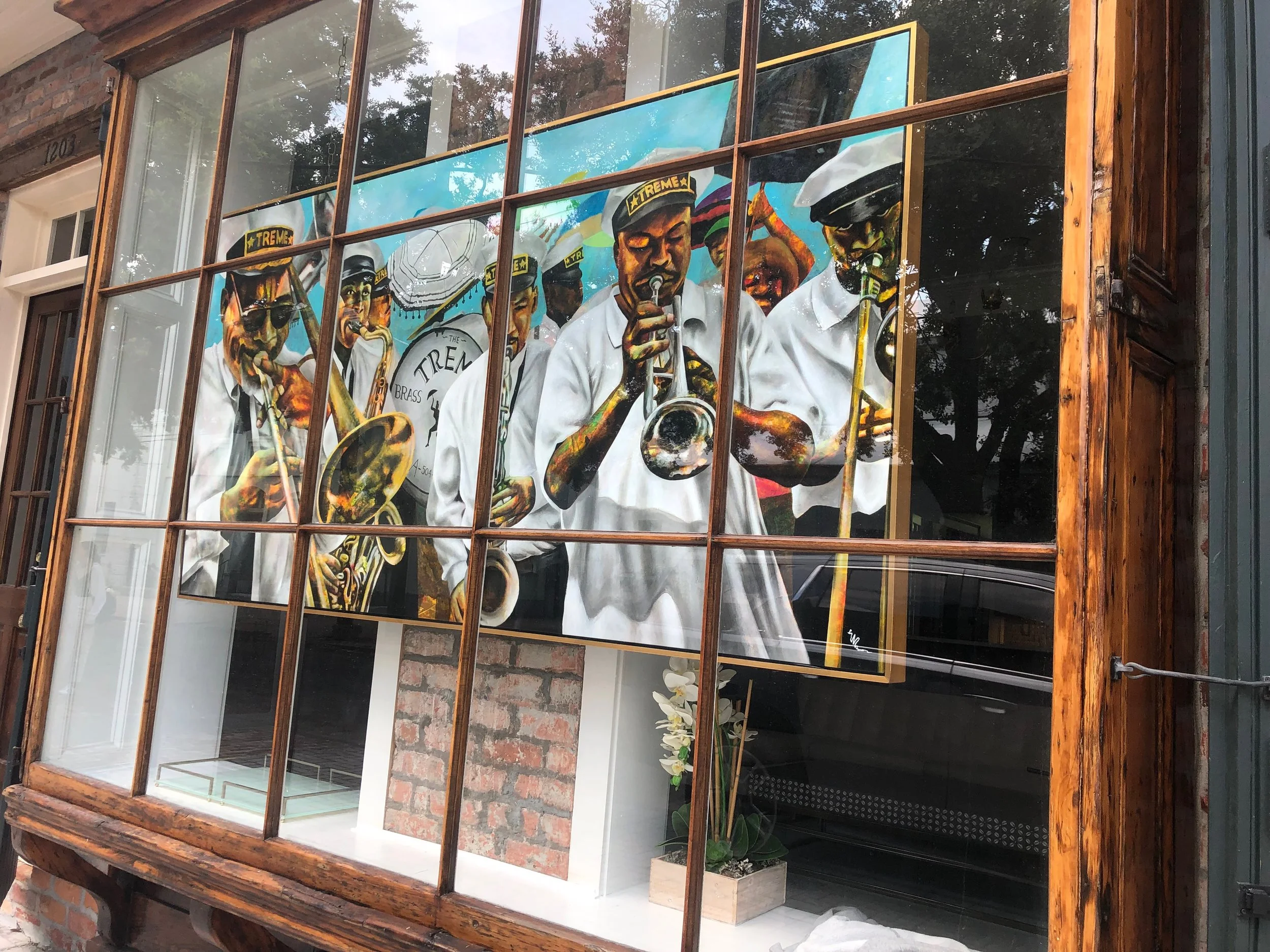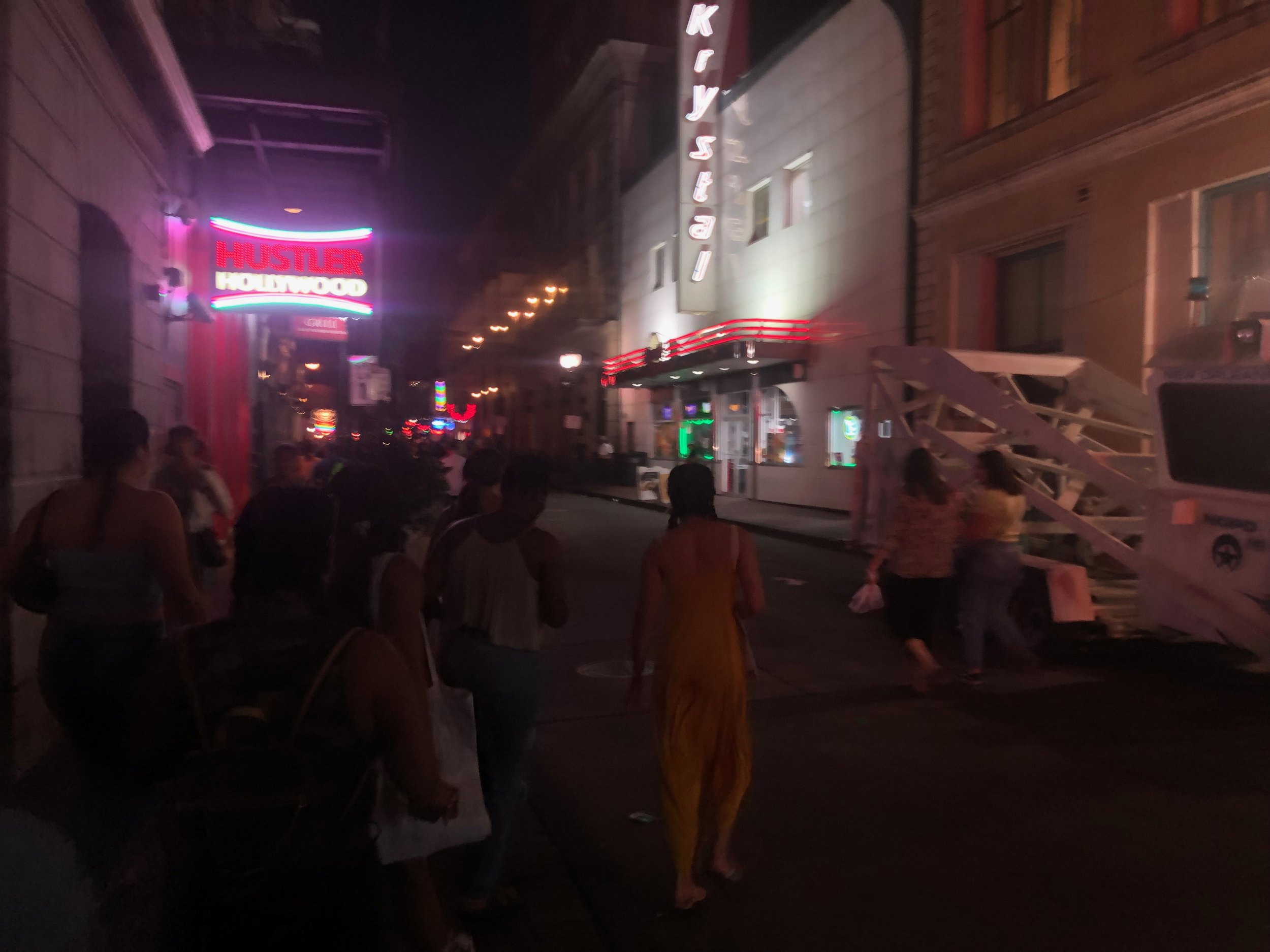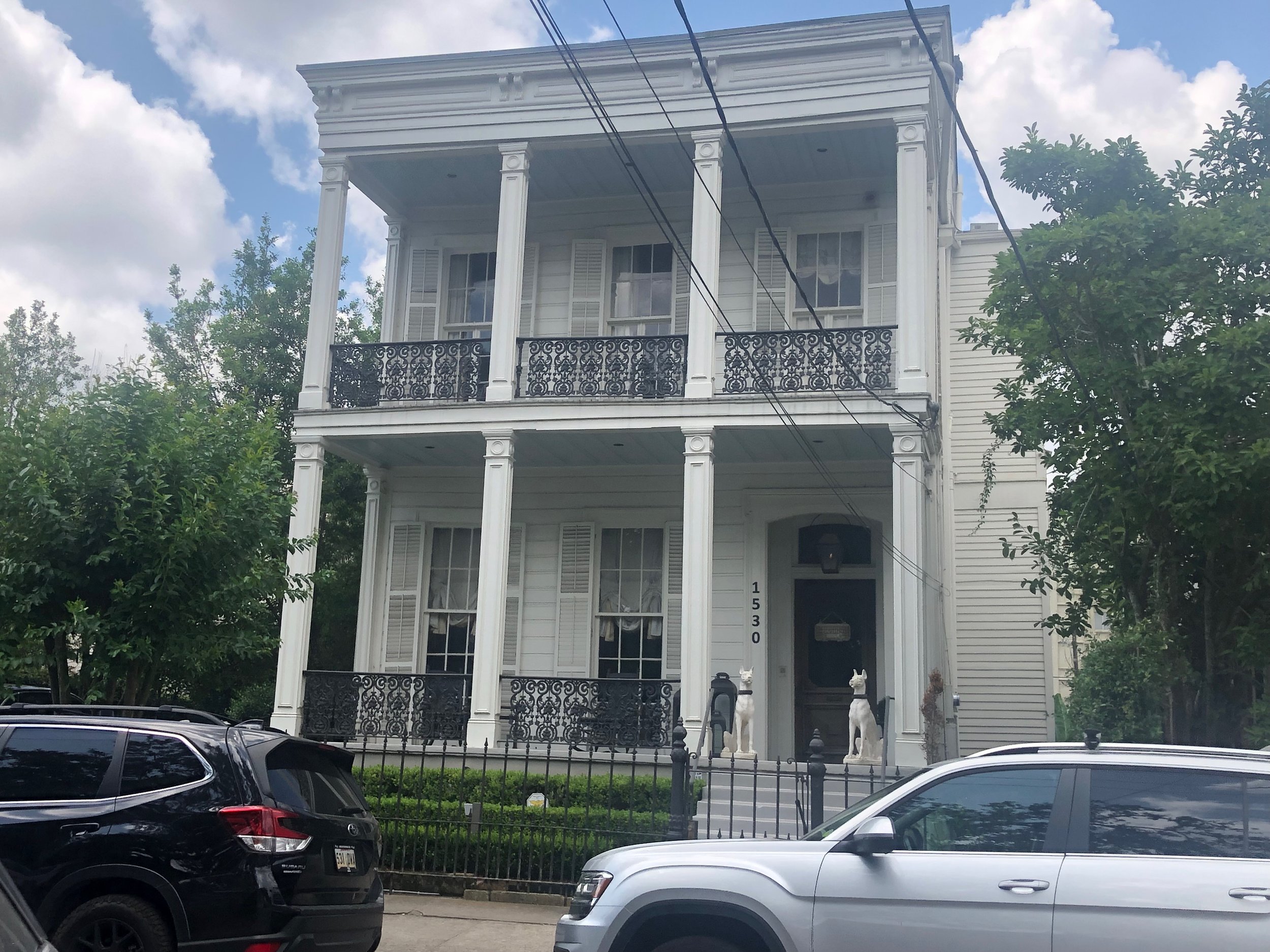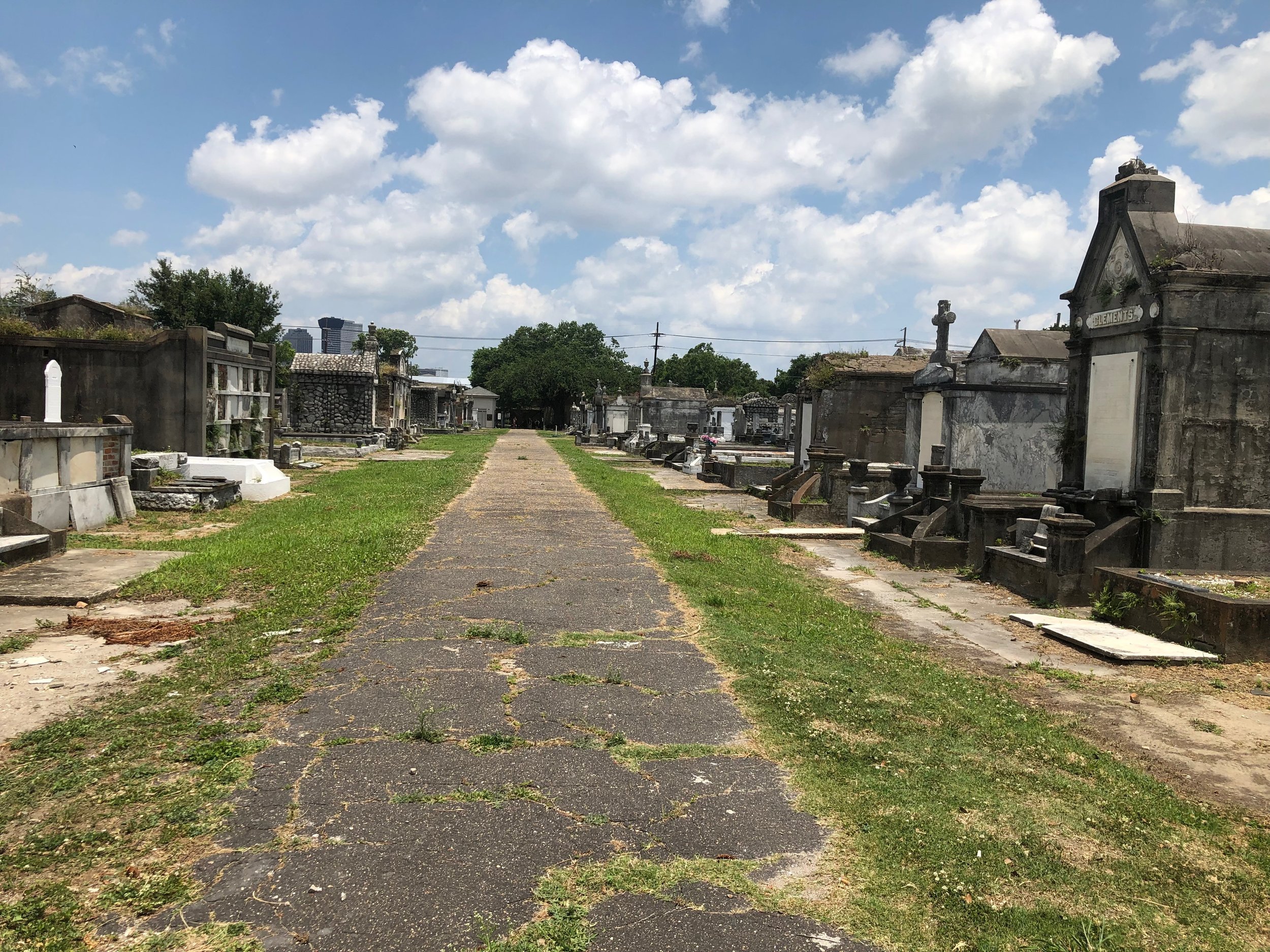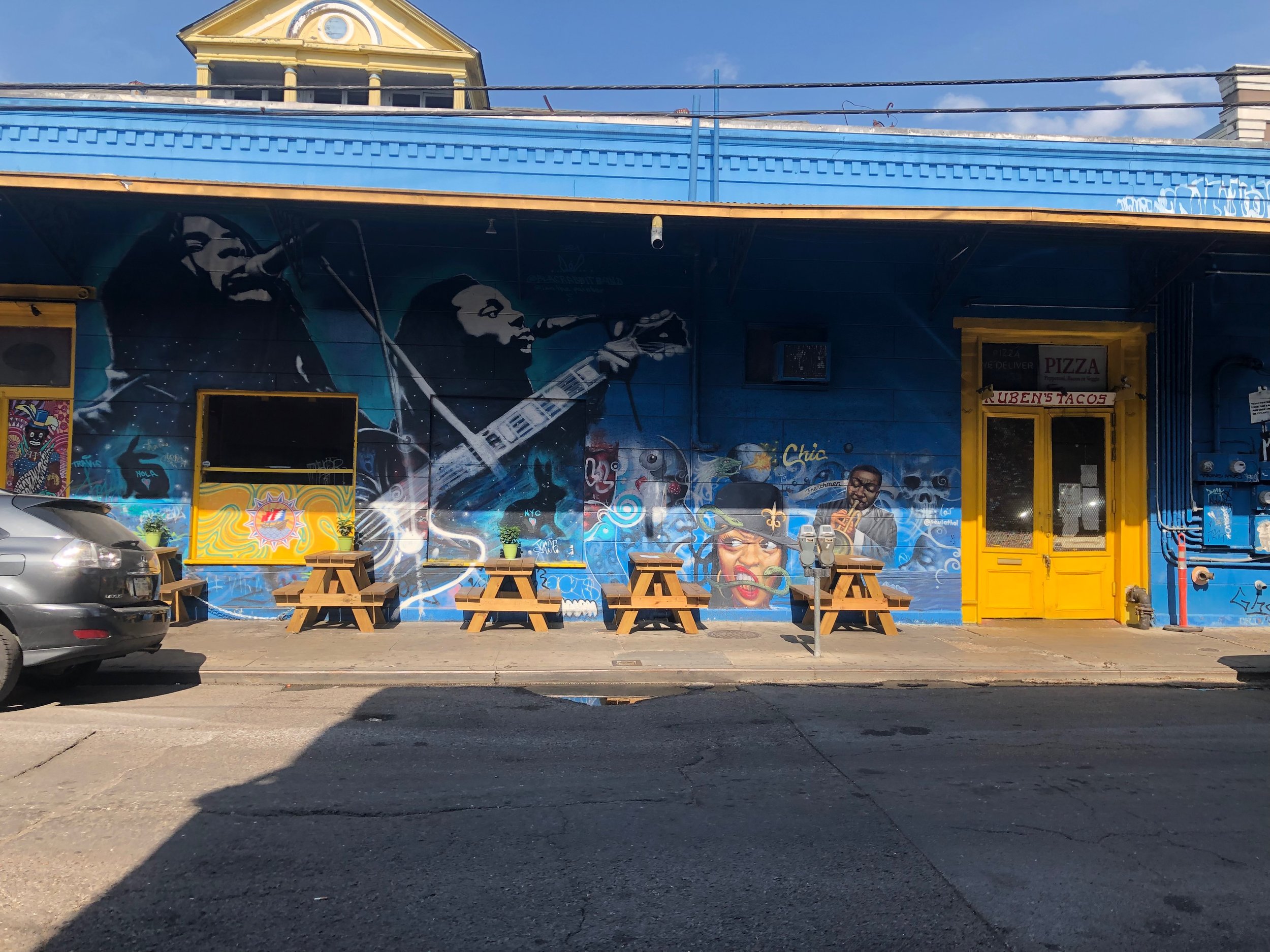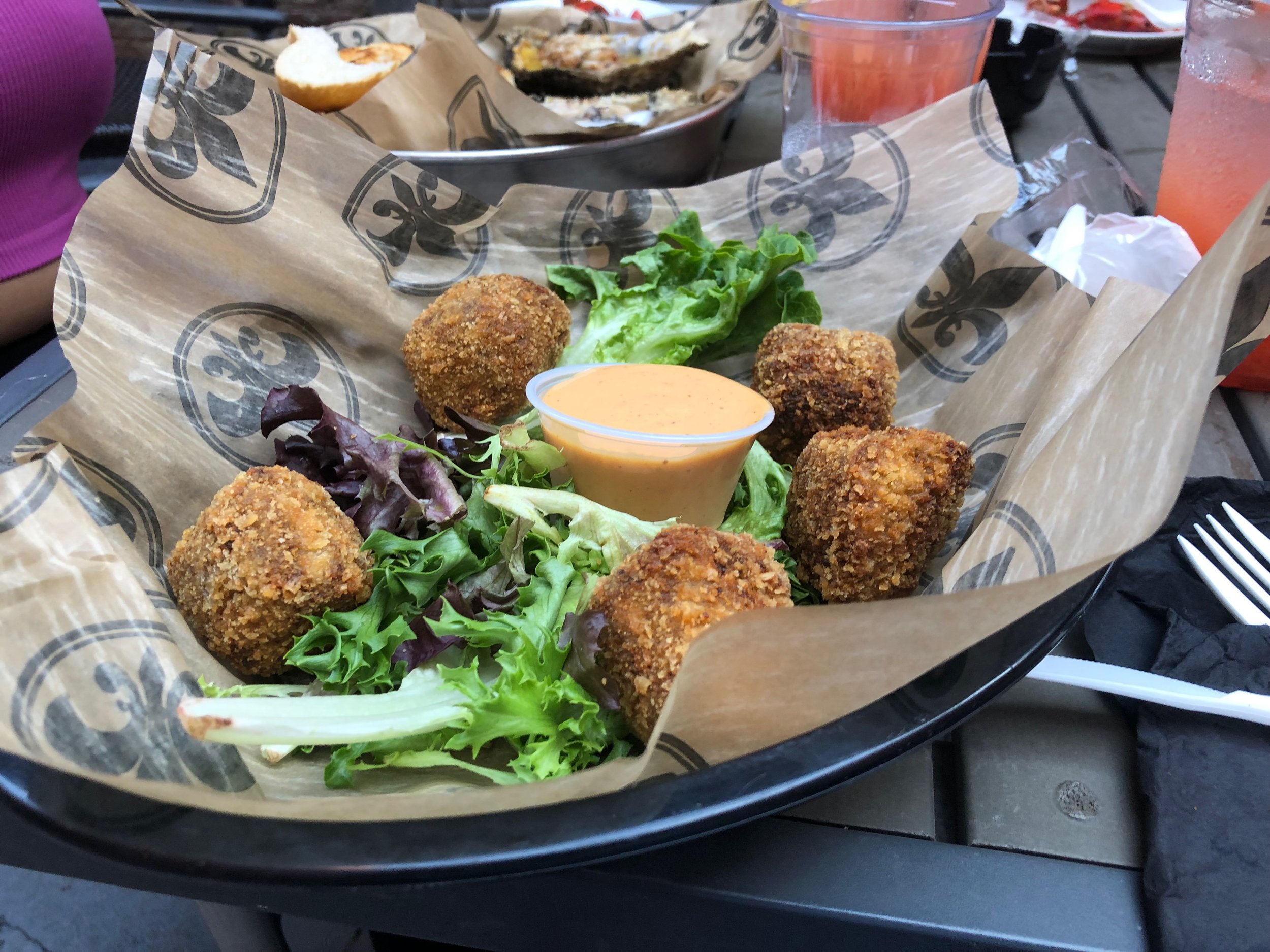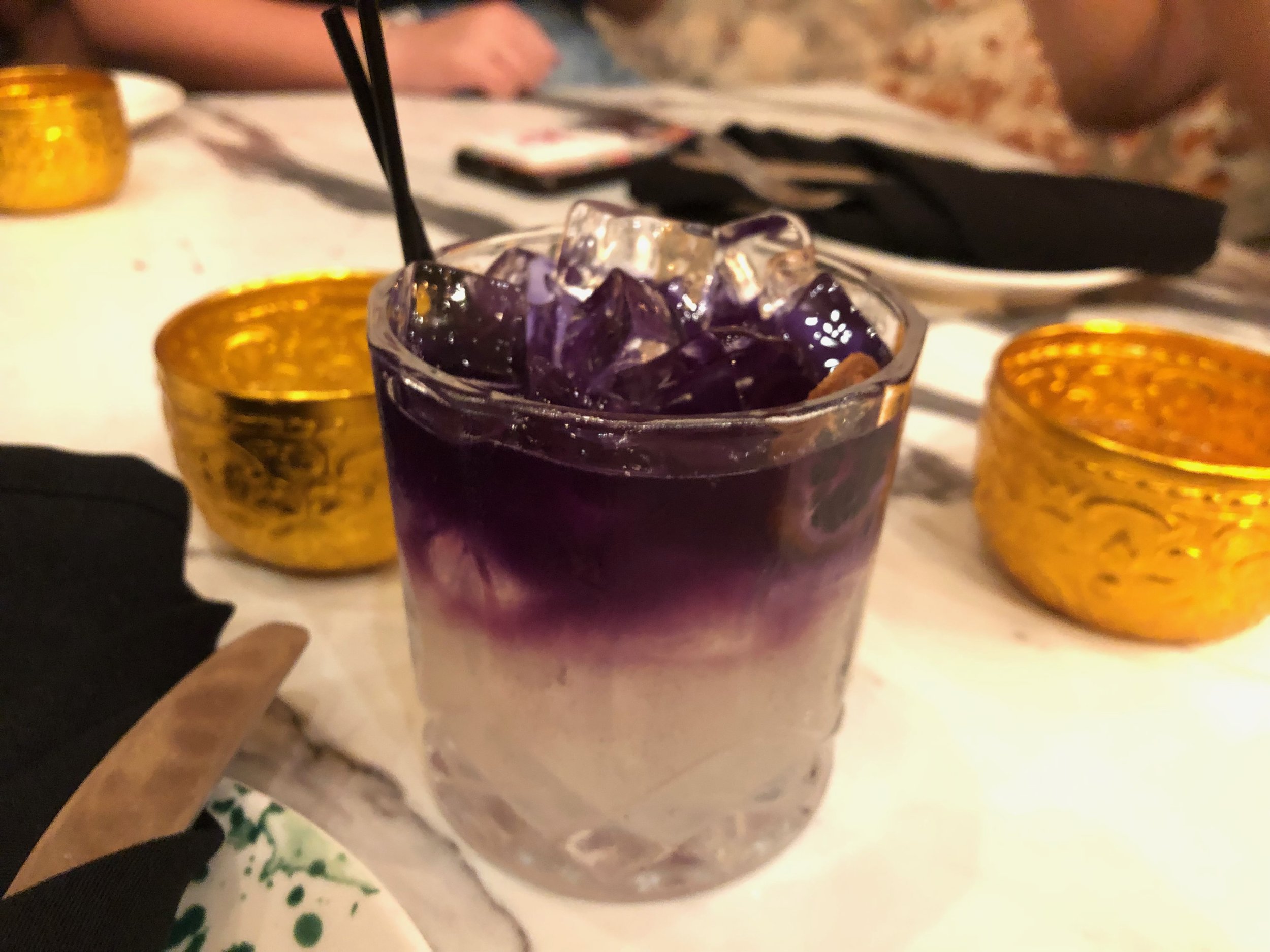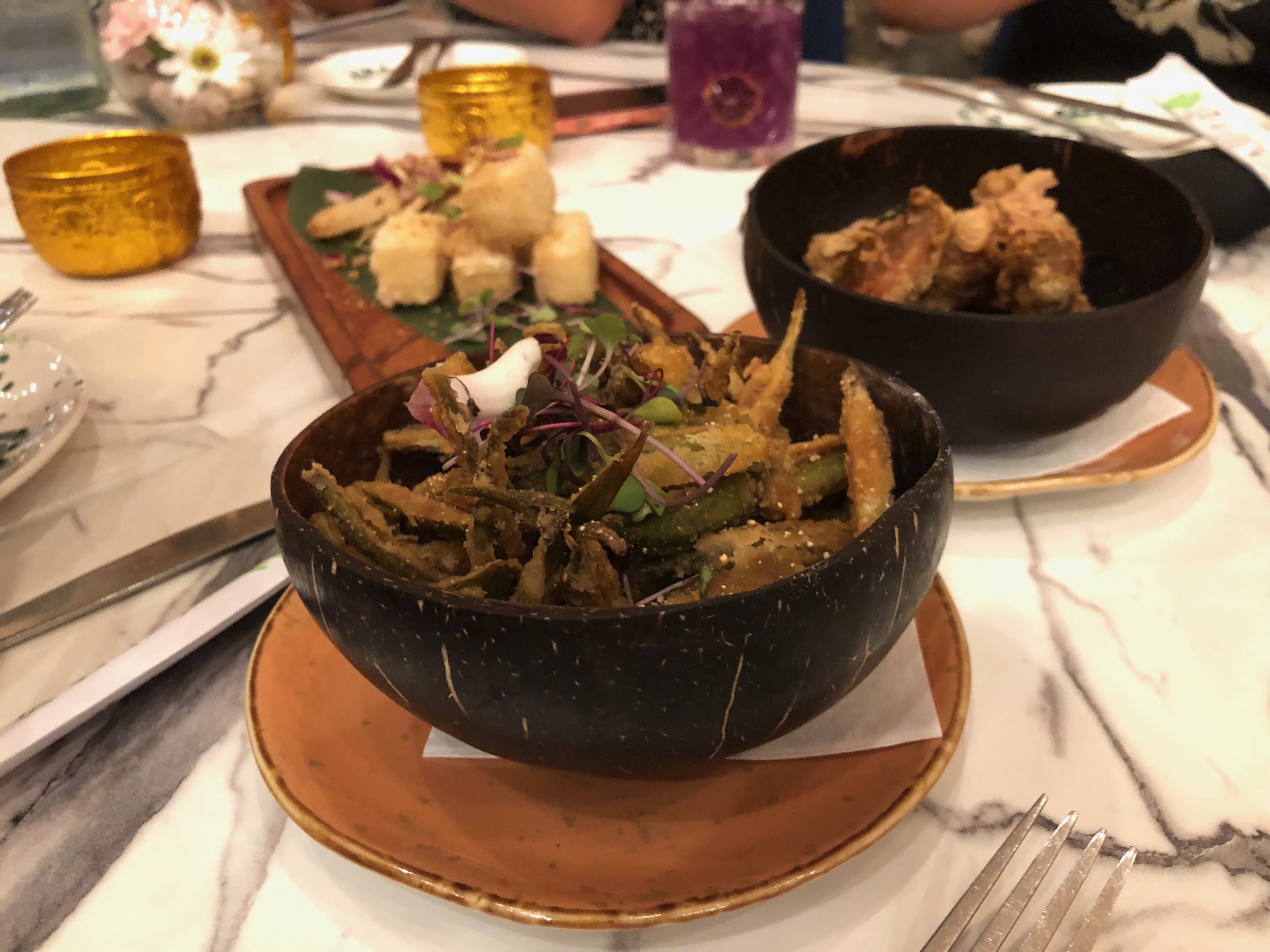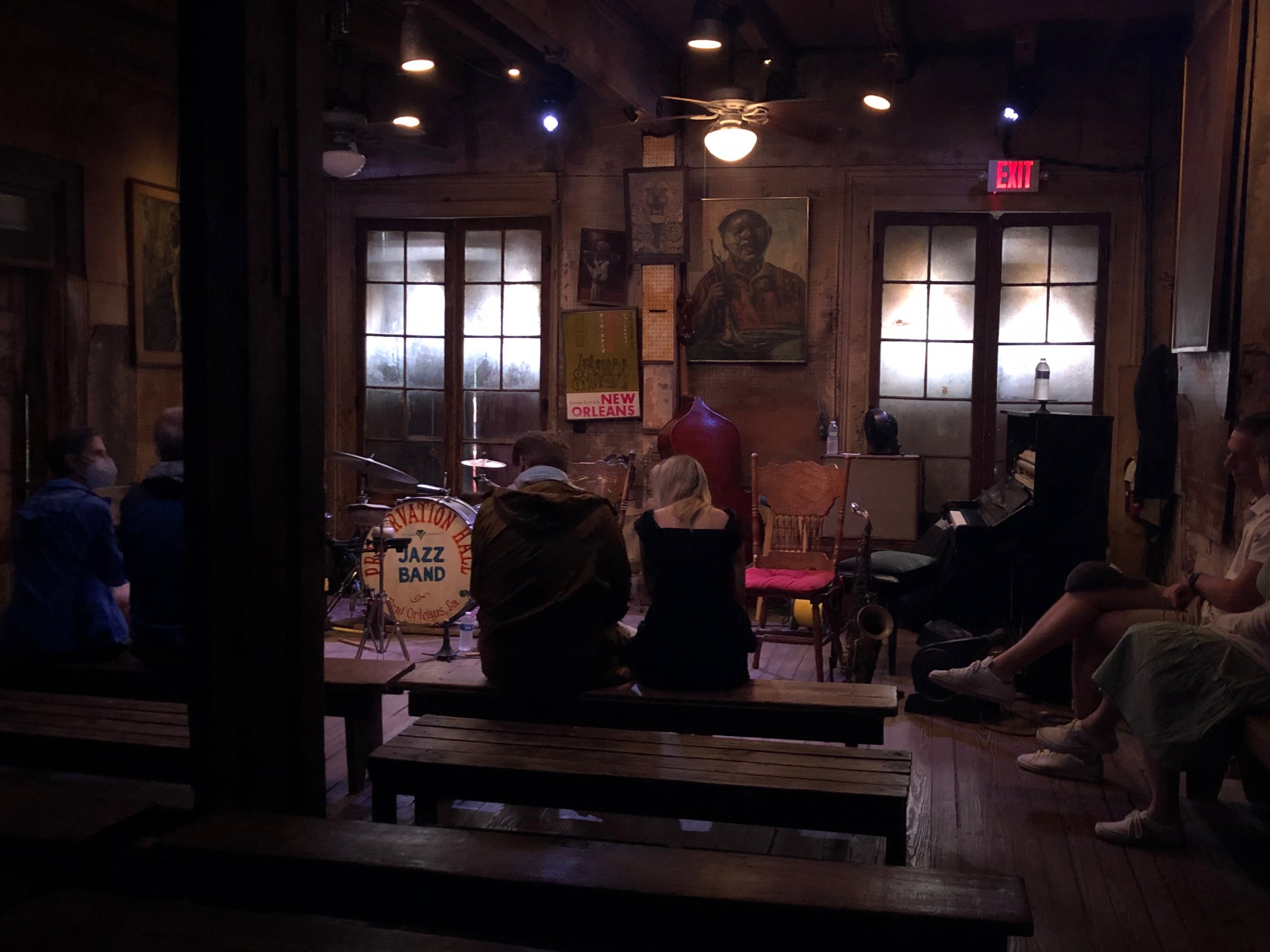The first night in New Orleans was a night I will not forget. The setting went as follows: a blending of old and new infrastructure, streetcars whizzing by in every direction, and a Willie’s Chicken Shack and daiquiri dispenser on nearly every corner. This town was a sinner’s best nightmare. I could not think of a better novel to prepare us for these ferocious streets other than Anne Rice’s Interview with The Vampire. Rice was a New Orleans native, born in the 1940s under a Catholic household. By the 1970s, Rice had a daughter who died of leukemia at the age of five. In 1976, Rice published this novel; one of the characters is a young vampire girl named Claudia, who is given a second chance at life after losing her parents. This new life, however, is one that is filled with death and despair. Although Claudia can no longer physically age, her mind ages with the times of her surroundings, molding her into an intelligent and fierce creature of the night.
“I saw my real gods…the gods of most men. Food, drink, and security in conformity.”
If I were a vampire, where would be the best place to masquerade? Well look no further than Bourbon Street. Since this was our first night in the Big Easy, me and the gang decided that it was time to immerse ourselves in one of the most notorious spots of this town. As I take each step, my eyesight was illuminated by all the dark wonders: debauchery, gluttony, and did I forget to mention the endless pizza splice counters? But do not be fooled by the bright neon lights, the kind solicitors, and the boisterous street performers. Just a like vampire, this street has fangs and will not give a second thought into who it punctures. So, as a gentle warning: do not venture into the night unless you have a companion, or two, by your side. As depicted through the words of the Frenchman Louis, companionship is a natural phenomenon that goes beyond just human tendency. Everywhere he ventures, Lestat and Claudia will be by his side to ride out the night until they must obey the rays of the sun and crawl back into the dank coffins from which they slumber.
“It was as if the very air were perfumed and peculiar there, and I felt an extraordinary ease walking on those warm, flat pavements, under those familiar oaks, and listening to the ceaseless vibrant living sounds of the night.”
Even after decades of living in New Orleans, Louis sees no immense change to the familiar sights and structures that he grew up admiring. In one of his descriptions of the city, Louis recalls the Garden District. Filled with mansions of all sizes and shapes, the district gives off this rich and luxurious oasis, distant yet connected to the heart of downtown NOLA. Every street that we walked on, we were greeted by these magnificent oak trees. The trees were nearly as tall as the mansions, with branches and limbs that could stretch across an entire intersection. These lengthy branches served a doubled-edged purpose: as communication lines, sending signals among the foliage on how to extract the most nutrients. Also, the limbs looked as if they were plotting on how to rip up the pavement and other man-made barriers. In the midst of these mega and mini mansions were two-story homes called double galleries. At this point, the French-Colonial theme has hit its highest stride: multiple columns on each floor, stacked onto each other in unison to showcase solidarity in the wake of the nature’s unkind shrubbery. This was a place where home dwellers could practice the exteriors of symmetry safely from the unknown and untouched green chaos that lay outside their doors. But in all honesty, I really did like these galleries as it made me appreciate the unique art styles in the cozy neighborhood that our group visited the day before: Treme.
Treme is one of those towns where people are enthusiastic about home design and, more importantly, expressing their self through that design. Gone were the lavish mansion-style homes and pompous two-story galleries; instead, we were welcomed by vibrant and colorful cottages and townhouses with the exception of a few shotgun houses to add some wild tunes to the scenery. Just to give a quick clarification on the differences, the cottages are smaller and usually just a single floor level. Townhouses, on the other hand, will typically be two stories high and are occasionally wrapped around by an ornate balcony. Shotgun houses, in contrast, are way tinier in square footage but do offer a sizable length, kind of like a loaf of bread. It was enlightening to be a part of these Creole roots, where people could live peacefully and express their chaotically beautiful minds on full display. Although they lacked freshly cut lawns, the individual looks of these homes more than compensated for this loss. Some boasted a purple haze coating, others a watermelon glaze. In comparison to the Garden District, we are again seeing the theme of unification, a different note is being played: unity through differentiation. Neighbors of all colors and backgrounds are coming together to bring something new to the band, and with each addition the artistic sound becomes richer and more whole.
This wood was repurposed from the devastation left by Hurricane Katrina.
“There was no city in America like New Orleans. It was filled not only with the French and Spanish of all classes who had formed in part its peculiar aristocracy, but later with immigrants of all kinds, the Irish and German in particular.”
During our brief stroll through Saint Louis Cemetery – No. 2 to be specific – I noticed that the names of the perished were not only names of French and Spanish descent. There were also Italian and German bones under the soil that I walked on. This speaks to Louis’s quote of the flooding of immigrants in the earlier days of New Orleans’s founding years. In the back of the cemetery were these massive mausoleum structures that stored dozens upon dozens of remains that belonged to a single guild, charity, and even a union workforce. One of these groups that caught my attention was the “Societee de Bienfaisance des Bouchers,” a society for butchers incorporated in 1867. Another community I found was “Cotton Yard Men,” incorporated in 1880. These men shared the same space just as they did in their former occupation but with their only means of company being the tall grass poking out of the red brick. Even if their souls did not find any loved ones or could not rest by the families they were born with, these men could depend on their secondary brothers to be there. This is the spirit of camaraderie at its best moments; through their involuntary connection with Lestat, Louis and Claudia form an unusual but necessary bond. In some ways, Louis is like a father to Claudia, guiding her on her vampiric transition with his possessed knowledge. While the years go by, their connection only grows stronger as their loved ones perish with their former lives. It is up to the next generation to tend to the needs of these graves, and the one after that.
Before going to the number 2, our original plan was to check out the St. Louis Cemetery No. 1. Unfortunately, due to serious grave decay, this location was closed for repairs. This city has been dealt two lethal blows: first COVID, then Hurricane Ida. The financial burden now looms over the restless souls which remain under the tombstones.
As our group headed out, we came across a seasoned veteran of the area by the name of Victoria (Vicky). Vicky was a kind old lady who knew a thing or two about these streets and gave us context on the current situation with the Mardi Gras parades, particularly with the Second Line. This is a group dedicated to not just filling the NOLA streets with jazz, but also to provide financial support for the proper burying of loved ones. Along with providing charitable works, there are groups like the Money Wasters whose civic duty is to uphold the community and its vibrant culture. However, as explained by Vicky, some of these groups have fallen on their obligations to look after the member’s generational graves, resulting in decay, deterioration, and – in some cases – significant cracking. This should not be the case; the second generation must be there for their members or else risk losing a piece of their heritage. The names on the stones may age, but the love for the family – whether related or not – shall never falter. After we thanked and said our goodbyes to Vicky, we marched on in search of the next divine meal. I could hear the bass of my stomach getting louder, a rumbling which could only be calmed by the tastes and smells of NOLA’s finest Southern cooking.
The first of many dining experiences in the Big Easy started with the birthday of one of our own. To celebrate Key’s turning of twenty-three, we gathered at Evangeline, a Creole / Cajun restaurant with high-end fixings. When the gang and I arrived, the waitress moved us to the outside seating, where a long table awaited us. We took our chairs and our eyes were immediately glued onto the menu…or at least mine were. This establishment had all the Creole essentials, with some fine dining twists in the mix. Tonight was not the night to play it safe; it was time that I ventured out of my comfort zone and explored the lesser known aspects of the Creole cuisine underworld. To assist my palate was a French 75, a concoction of lemon juice and champagne with a hint of gin. The order went in as follows: fried okra, fried green tomatoes, and alligator Creole. Let’s talk about alligator meat. Have you ever eaten gator? Are you afraid of the texture? Well, I sure as heck was until the plate came over. On the bottom of the simmered gator bits were diced tomatoes, soaked in an acidic bath and fluffy white rice soaking in both the tomato and the tangy sauce. All these flavorful notes were in sync when I put that first spoonful to my mouth. The gator, to my surprise, had a chicken-like texture backed with the bite of a cow. Yes, it was like eating a juicy, fatty piece of steak but with less of the guilt. As I munched down on my prey, I slowly raised my glass in honor of the birthday celebration. Dessert was not out of the picture; the gang made an unanimous decision to order beignets – bread pudding style – as well as a brown butter sugar cake…don’t even get me started on this cake. It was like biting into a warm block of sugar with oozing brown sugar syrup dripping down it. The flavor was extremely rich but delightful. This event would go down in history as one of my most deliciously satisfying nights in the city. Little did I know this euphoric feeling would only last so long.
The next day, me and some of the gang ventured back into Frenchman Street, a vibrant destination for those who desire a little bit of live music and a little bit of fresh seafood. One of the restaurants we stopped at was this jazz & blues bar named 30/90 NOLA. 30/90 was the place to come after a long day of parading; live jazz music filled the atmosphere, washing over our fragile minds and persuading us to partake in a jig. In the back of the bar was where we sat, outside in the semi-cool shade. Our group was greeted by a caterer whose Instagram handle is ChefDJ504. The caterer did not bring us any hip-hop beats, but she sure did know how to whip up a mean crawfish boil. Did I mention that this was going to be my very first time eating crawfish? Along with the boil, we ordered an abundance of delicacies including jambalaya, po’boys, gumbo, boudin, mini muffulettas, and a lake’s worth of fresh oysters. The muffulettas had left much to desire as this wasn’t my first rodeo with iconic sandwich. This dish would not exist if it wasn’t for the early Italian immigrants who accepted and made this city their new home. As the dishes kept rotating in, my nasal passages picked up a salty, spicy, fish-like aroma originating from the caterer’s pot. The crawfish was ready to be devoured by hangry college students. The technique for consumption went like this: twist the head off and suck out the juices, followed up by the peeling of the shell and eating the delicate meat. At first bite, I was met with a vicious coughing brought on by the pungent spices. When the spices subsided, I licked my lips and took a deep breathe…absolute satisfaction. This was a common Creole dish fit for a poor king. I eventually got my fingers around one of the boudin balls which packed a savory salty crunch; boudin is a type of French blood sausage. It’s like they say, you can’t have proper Creole without the addition of a few French items. As I childishly played with the freshwater crustacean in my hand, A wonderful French phase kept repeating in my head: “Laissez les bon temps rouler” (let the good times roll). And the good times were indeed rolling, rolling me straight into a severe food coma. Thankfully, I had my hurricane drink to bring me back from the drowsy state. Rum, sugar, spices, seafood, and smiles all around. United, we took the menu by storm and made good on our promises to keep our stomachs from rumbling that day.
Digging into some boiled crawfish with the gang.
One of the last dining extravaganzas that I felt compelled to include on this blog was Thai night. Our group had grown weary of the Cajun spices and a needed a new flavor that could satisfy our cravings. The decision came down to a restaurant called Thaihey Nola. Inside, we befriended this very kind waitress who was bubbling with pure joy and laughter. If there was anyone who could reverse the mood of the most depressed being, it would be this lady. The night called for a Mai Tai; without this beverage in hand, I felt like a vampire trying to blend in during Mass. So, I stuck with the theme from the sip of my beverage to the last slurp of my soup. The table was littered with Thai classics like crispy tofu, crab fried rice, and Tom Yum Boran noodle soup. The tofu was seasoned with a Creole taste that burned so well on the rims of the mouth. In the soup were these generous clumps of spicy pork and scattered crushed peanuts. The routine for maximizing flavor intake was to chew, to slurp, and to crunch. While I was distracted by the Thai symphony, some Southern staples had invaded my territory and started to chime in loudly. The first of these invaders was the fried okra which was dusted with a Tom Yum sauce. To clarify for my foodie enthusiasts, Tom Yum refers to a hot and sour soup base found commonly in Thai cuisine. The second intruder was a little more thorough with its hiding technique: fried chicken bits that just came out of a spicy green curry shower. These comforting foods proved that fusion works under the right circumstances, and Thaihey has aced this concept with flying colors. The word camaraderie comes from the French term “camarade,” which means “friend” or “companion.” Sharing the dishes amongst ourselves worked yet again. If you seek to dine, dine in company and you will go far. Dine alone, and you may be robbing yourself of a lost opportunity for your taste buds. With our minds completely blown for the third consecutive night, we stumbled toward the door and into the humid streets of NOLA.
The Tom Yum Boran noodle soup, filled with juicy pieces of sausage and crisp green beans.
DAM if we do, DAM if we don't
〰️
DAM if we do, DAM if we don't 〰️
Just today, our group was blessed with an abrupt change of plans. Rather than watch the Divine Ladies, we had the pleasure of being a part of the Dignified Achievable Men (DAM) Social & Pleasure Club (SAPC). It was an electrical experience, walking with the crowd and the group members. The musicians fired off their worn-down tubas and the sea of people followed. Some of those in the crowd added improvised instruments into the jam session. A couple of floats passed by, carrying true patriots of the Second Line. At the conclusion of our march down Claiborne Avenue, I was sweating and shaking not just from the heat but also from the sheer thrill of this event. These SAPC’s embodied the energy of the community perfectly, and I was truly honored to be a part of that sea of ecstasy even if just for a brief march.
The band’s march comes to a satisfying conclusion.
“If you don’t shake, don’t get no cake.”
After going through our vampire phase, we transitioned to Michael Ondaatje’s Coming Through Slaughter. The book focuses on the life of one of the greatest jazz musicians ever to live, Buddy Bolden. The story takes us through Storyville, a red-light district that was notorious for its prostitutes up until 1917. With most of the buildings destroyed, all that remain are housing projects and apartment complexes. During this time, Bolden played a heavy hand in the early developments of the jazz genre. On a Saturday afternoon, me and the gang went to Preservation Hall, a music venue that has stood in place since the 1960s. This was another magical destination for feeling the wild rhythms of jazz. Once inside, we congregated at the very back of the room where we stood with unwavering anticipation. The band slowly creeped onto stage and resumed their seats. In the blink of an eye, a saxophone cried out for attention. Next came the soothing melodies of the flute. The drums and the piano were also feeling vigorous that day. Each instrument could drift off from the beaten path of the band’s melody and come back without disrupting the flow. At times of passion, the band members individually stood up and expressed their identity through their own divine tune. This fragmented play style mimics the uncontrollable mental state of Bolden throughout Ondaatje’s book. Diagnosed with schizophrenia, Bolden had an extremely difficult time reading off of sheet music. And yet, this man knew how to tame a cornet to fit his vivid imagination. It was hard for me not to get into a shaking rhythm when the jazz notes were filling up at Preservation Hall. Divided, these band members played very well; but united, they channeled the very essence of jazz’s roots.
New Orleans is the place to both lose and find yourself. Are you a nocturnal beast with no eating preference, hell-bent on slurping up daquiris until 4am? Are you the foodie connoisseur who avoids sketchy establishments and makes it their lifelong mission to try every item on the menu regardless of what your friends say? Or are you both? Whichever identity you decide to masquerade as, just know that NOLA will still welcome you with open arms and tables.
